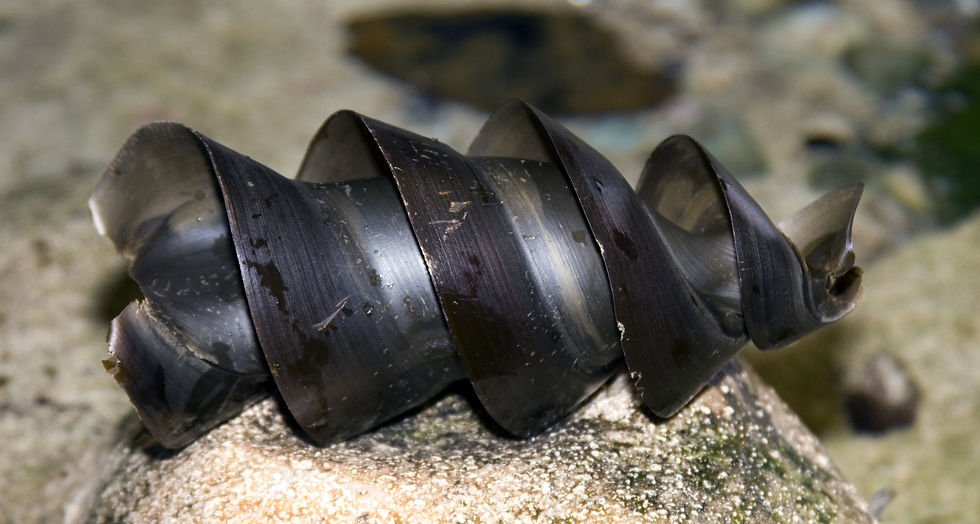One of the things that is most fascinating about sharks, is how remarkably varied their reproductive methods are. Shark reproduction is far more diverse compared to other animal groups - Despite being closely related, some sharks give birth to live young (known as "viviparity"), whilst others lay eggs ("oviparity"), where others hatch eggs internally, to then give birth to live young ("ovoviviparity"). Even when we talk about only oviparous sharks, there is still an incredible range of contrasting egg cases and reproductive strategies, employed by different sharks. So what are all these different strategies? And why are they so diverse?
A Good Egg
You might think that all sharks and rays that lay eggs will be similar, but this is not the case! Egg-laying occurs across many different taxonomic groups of sharks, popping up randomly amongst different reproductive strategies within groups of closely related species. All members of the order of bullhead sharks (Order Heterodontiformes) are oviparous, but egg-laying can also be found in some species of carpet sharks (Order Orectolobiformes) and ground sharks (Order Carcharhiniformes) (Abel & Grubbs, 2020; Ebert et al, 2021).
The ground sharks are, in fact, the youngest group in terms of evolutionary history of sharks. Because some lay eggs, but many give birth to live young, scientists wonder whether ovipary or vivipary came first. We originally thought that egg-laying sharks came first in evolutionary history and live-bearing sharks evolved more recently, but some scientists now wonder if all sharks were actually originally viviparous and egg-laying then evolved later on. To learn more you can check out What Came First, The Shark or the Egg? (Abel & Grubbs, 2020; Nakaya et al, 2020; Ebert et al, 2021).

Mommy Dearest
Amongst oviparous sharks, there are massive differences in their reproductive methods. If you take a glance at the egg cases of different sharks, you can see immediately how different they are - varying in size, shape and colour (Abel & Grubbs, 2020; Ebert et al, 2021).
But there are other differnces too - the way that the eggs develop within the mother can also vary enormously from species to species. Some oviparous sharks reproduce by "single oviparity" also known as "immediate oviparity". This means that the female has a single egg case in each of her two "oviducts", which are only retained for a very short time before being laid. This means a pregnant female will only carry two embryos at any one time, but she can repeat this process, in order to have dozens of offspring within one spawning season. The egg cases of these sharks are commonly thick and strong, to protect them from damage and corrosion during the extended peiod they develop outside of the mother. They also have long tendrils to ensure they remain anchored securely in their hidey hole whilst they are developing outside the mother on the ocean floor (Nakaya et al, 2020).
Comparatively, sharks which reproduce by "retained oviparity" also known as "multiple oviparity" or "delayed oviparity" will have numerous egg cases during each pregnancy. These eggs remain within the female for much longer and so they develop more extensively before they are laid. The tendrils of these egg cases are shorter and finer, as they don't need to remain anchred to the ocean floor for long (Nakaya et al, 2020).

A Hard Egg to Crack
As if it wasn't all complicated enough, a group of scientists in Malaysia recently discovered that shark reproduction might be even more diverse than we previously thought! They learned that the Sarawak swellshark (Cephaloscyllium sarawakensis), did not fit into either the single oviparity or the multiple oviparity category. Instead, these sharks had a single egg case in each oviduct (like single oviparity), but also retained the eggs for an extended period of time, to allow the embryo to develop more fully (like multiple oviparity) (Nakaya et al, 2020).
The eggs of these sharks had a tough, thick shell, very long, strong tendrils for attachment and a smooth surface which was completely transparent, so the scientists could clearly see the yolk and the developing embryo inside (Nakaya et al, 2020).
The researchers concluded that this shark has a different method of reproduction than it's close relatives, so they coined a new term to describe it; "sustained single oviparity" (Nakaya et al, 2020).
The scientists suggested that retaining the eggs within the mother for an extended period is advantageous for this species, because it offers the offspring added protection from predators. Upon depositing the eggs, the transparent egg case is perfectly adapted, as the patterned, pigmented skin of the small sharks camouflages them against the seabed. They also noted that, whilst this reproductive strategy limits how many offspring each mother can have during one spawning season (known as "low fecundity"), it allows the offspring to be born at a relatively large size (around 12cm long). As this species must only reach around 35 cm length to be sexually mature, they are able to maintain a relatively high "lifetime fecundity", by rapidly growing to maturity and reproducing many times throughout the course of their lives (Nakaya et al, 2020).
With babies this weirdly cute... who wouldn't want to have lots of them!
If you find all this fascinating, you can check out my other articles on shark reproduction.
References
Abel DC & Grubbs RD (2020). Shark Biology and Conservation: Essentials for Educators, Students, and Enthusiasts. Johns Hopkins University Press, Canada. IBAN: 9781421438368.
Ebert DA, Dando M& Fowler S (2021). Sharks of the World: A Complete Guide, Second Edition. Princeton University Press: UK. IBAN: 978-0-691-20599-1.
Nakaya K, White WT & Ho HC (2020). Discovery of a new mode of oviparous reproduction in sharks and its evolutionary implications. Scientific Reports, 10, 12280. Access online.
By Sophie A. Maycock for SharkSpeak












Comments